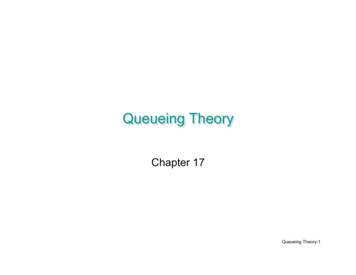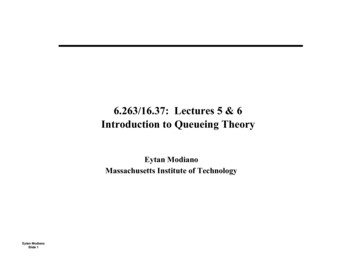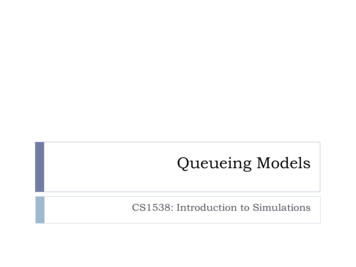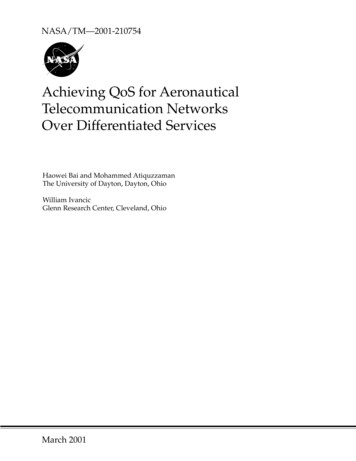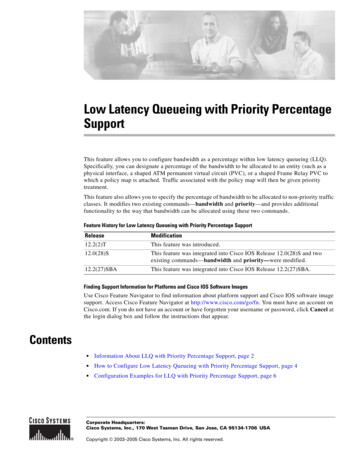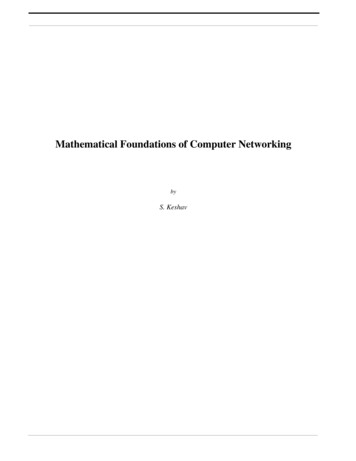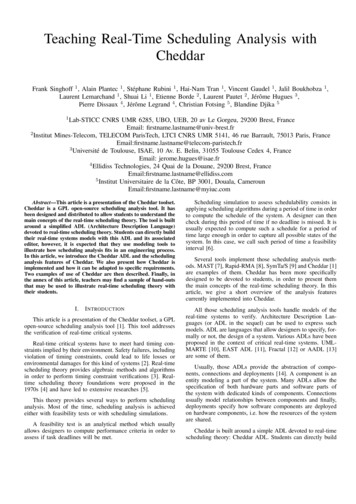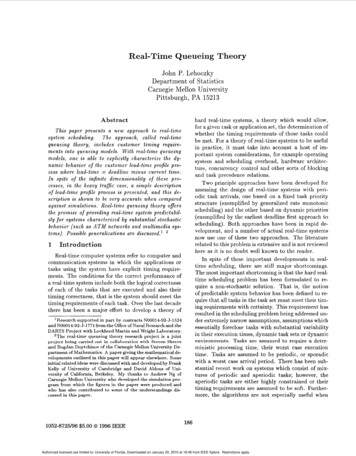
Transcription
Real-Time Queueing TheoryJohn P. LehoczkyDepartment of StatisticsCarnegie Mellon UniversityPittsburgh, PA 15213Abstracthard real-time systems, a theory which would allow,for a given task or application set, the determination ofwhether the timing requirements of those tasks couldbe met. For a theory of real-time systems to be usefulin practice, it must take into account a host of important system considerations, for example operatingsystem and scheduling overhead, hardware architecture, concurrency control and other sorts of blockingand task precedence relations.Two principle approaches have been developed forassessing the design of real-time systems with periodic task arrivals, one based on a fixed task prioritystructure (exemplified by generalized rate monotonicscheduling) and the other based on dynamic priorities(exemplified by the earliest deadline first approach toscheduling). Both approaches have been in rapid development, and a number of actual real-time systemsnow use one of these two approaches. The literaturerelated to this problem is extensive and is not reviewedhere as it is no doubt well known to the reader.In spite of these important developments in realtime scheduling, there are still major shortcomings.The most important shortcoming is that the hard realtime scheduling problem has been formulated to require a non-stochastic solution. That is, the notionof predictable system behavior has been defined to require that all tasks in the task set must meet their timing requirements with certainty. This requirement hasresulted in the scheduling problem being addressed under extremely narrow assumptions, assumptions whichessentially foreclose tasks with substantial variabilityin their execution times, dynamic task sets or dynamicenvironments. Tasks are assumed to require a deterministic processing time, their worst case executiontime. Tasks are assumed to be periodic, or sporadicwith a worst case arrival period. There has been substantial recent work on systems which consist of mixtures of periodic and aperiodic tasks; however, theaperiodic tasks are either highly constrained or theirtiming requirements are assumed to be soft. Furthermore, the algorithms are not especially useful whenThis paper presents a new approach to real-timesystem scheduling. The approach, called real-timequeueing theory, includes customer timing requirements into queueing models. With real-time queueingmodels, one is able to explicitly characterize the dynamic behavior of the customer lead-tame profile process where lead-time deadline minus current time.In spite of the injinite dimensionality of these processes, in the heavy trafic case, a simple descriptionof lead-time profile process is presented, and this description is shown to be very accurate when comparedagainst simulations. Real-tame queueing theory offersthe promise of providing real-time system predictability for systems characterized b y substantial stochasticbehavior (such as ATM networks and multimedia systems). Possible generalizations are discussed.l1IntroductionReal-time computer systems refer to computer andcommunication systems in which the applications ortasks using the system have explicit timing requirements. The conditions for the correct performance ofa real-time system include both the logical correctnessof each of the tasks that are executed and also theirtiming correctness, that is the system should meet thetiming requirements of each task. Over the last decadethere has been a major effort to develop a theory of'Research supported in part by contracts N00014-92-5-1524and N00014-92-5-1771 from the Office of Naval Research and theDARTS Project with Lockheed Martin and Wright Laboratory.2The real-time queueing theory research project is a jointproject being carried out in collaboration with Steven Shreveand Bogdan Doytchinov of the Carnegie Mellon University Department of Mathematics. A paper giving the mathematical developments outlined in this paper will appear elsewhere. Someinitial related ideas were discussed with and developed by FrankKelly of University of Cambridge and David Aldous of University of California, Berkeley. My thanks to Andrew Ng ofCarnegie Mellon University who developed the simulation program from which the figures in the paper were produced andwho has also contributed to some of the understandings discussed in this paper.1052-8725196 5.00 0 1996 IEEE186Authorized licensed use limited to: University of Florida. Downloaded on January 20, 2010 at 18:46 from IEEE Xplore. Restrictions apply.
the total workload is dominated by aperiodic activity.to queueing models greatly complicates the analysis ofThe very narrowly defined scheduling problem permits the development of scheduling algorithms bothwith good performance and for which an explicit determination of task timing requirement feasibility canbe made under fairly broad but deterministic conditions (for example the conditions supported by generalized rate monotonic scheduling). Unfortunately,this formulation is so narrow that many of the mostimportant real-time system applications, especiallythose involving multimedia, real-time communicationson ATM networks and robotics problems, cannot beaddressed. Those applications have task processingtimes which are stochastic, especially in the multimedia context where voice and video transmissions exhibit great variability and may involve dynamic environments. It is simply impractical to assume a worstcase execution times for each task when the executiontime variance is high, because on average the systemwill be highly underutilized.For real-time systems for which the task sets exhibitsubstantial variability, one would like to develop approaches based on queueing theory, a theory which wasdesigned to model and predict stochastic system behavior with resource contention. This theory is basedon allowing randomness in the task arrivals and taskexecution times. The difficulty with queueing theoryis that this theory does not typically allow for explicitconsideration of task timing requirements. Instead, itonly permits priorities which allow important tasks ortasks with short timing requirements to receive preferential treatment. However, queueing theory usuallyfocuses on general system performance measures, suchas task delay, queue lengths, processor utilization, etc.,and these are usually computed under equilibrium assumptions. It does not model the timing requirementsof each customer, nor does it analyze the ability ofa scheduling algorithm to meet those timing requirements, although this is what is needed for real-timesystems. What is needed is a new theory which combines the focus on meeting task timing requirements asstudied in real-time scheduling theory with the focuson stochastic task sets as studied in queueing theory.those models. Customers will arrive with a given timing requirement, for example a particular hard deadline, i.e. an initial laxity. As time evolves, the laxitywill change, depending upon which customers are receiving service and their service requirements. Thus,the state of the real-time queueing system includesnot only the number of customers in the system, butalso their residual service requirements and the timeremaining until the deadline elapses, both of whichchange dynamically. Consequently, the state variableof such a queueing system is of unbounded dimension,a fact which appears to make an exact analysis extremely complex, possibly infeasible.Fortunately, there is an approach to handling theinfinite dimensional problem. For the situation inwhich one has a simple Markov model with Poissonarrivals and exponential service times (and arbitrarycustomer deadline distributions), the problem can beformulated and solved, at least in principle, althoughthe solution is very complicated. It turns out, however, that if one focuses on the (‘heavy traffic” case(where the traffic intensity on the processor convergesto l), then this very complex system has a solutioncharacterized by a surprising simplicity. Furthermore,simulations validate these results. In addition, if onecan characterize the behavior of the system underheavy traffic, one can generate a worst case bound onsystem performance for the smaller traffic intensities.The reader will immediately be concerned that thereal-time queueing theory that is being presented inthis paper will only work for very simple queueingsystems, those characterized by Poisson arrivals andexponential service times. In fact, in the heavy trafficcase, the results generalize to much more general models, models with arbitrary renewal arrival processesand arbitrary service time distributions. More importantly, the methodology can be extended to queueingnetworks, so for the first time, we have the potentialt o study analytically end-to-end delay and satisfactionof customer timing requirements under stochastic conditions. Finally, the methodology opens up the possibility of directly modelling, analyzing and optimizingqueueing control policies, or real-time scheduling policies. It also appears that the methodology will be ableto handle periodic task sets (which are tasks with degenerate renewal process arrivals) and mixtures of periodic and aperiodic tasks. In the next section we willoutline the basic theory. The methods rely on a mathematically sophisticated part of the theory of stochastic processes including: weak convergence of queueingprocesses to reflected Brownian motion, Markov pro-The purpose of this paper is to present an introduction to a promising new theory that appears tobe able to combine the best of both of these disciplines, real-time queueing theory. This theory beginsfrom the point of view of queueing theory; however, itmust be able to answer questions that arise with realtime systems, especially whether or not a system willbe able to satisfy the timing requirements of a taskset. Of course, adding customer timing requirements187Authorized licensed use limited to: University of Florida. Downloaded on January 20, 2010 at 18:46 from IEEE Xplore. Restrictions apply.
[t,t 51,if a customer has not departed, then its leadtime is reduced by S. Negative lead-times are possibleand indicate that a customer is late. In some systems with hard deadlines, lateness is not permitted.Thus when a customer becomes late, its processingis stopped and it is removed from the system with atiming fault being recorded. The theory we are developing accommodate both cases in a single analysis,but we do not pursue this here.cesses evolving on the space of Fourier transforms andsemi-group theory. In spite of this, a reader who isfamiliar only with the basic theory of Markov chainsand queueing theory should be able to follow the present at ion.2The Basic ModelWe introduce the ideas associated with real-timequeueing theory through a simple M/M/ 1 queueingmodel. We make the following assumptions:A l : There is a single processor that services tasks(customers) at rate 1.A2 : Customers arrive according to a Poisson processwith rate A.A3 : Customers have service requirements which require an exponential time for the server to complete with mean l/p.A4: Each customer arrives with a hard relative deadline drawn from a probability distribution havingcumulative distribution function G, and characteristic function F(s) e i " " d ( z ) . The absolute customer deadline is the relative deadlineplus the current (arrival) time.A5 : There is a queue discipline which governs the order in which customers are processed. Preemption is permitted (we assume preempt-resume),and it is assumed to result in no overhead.Assumption A5 is vague concerning the specific queuediscipline or scheduling algorithm being used. In thispaper, we will focus on specifically on (1) earliest deadline first (edf) and (2) processor sharing (ps). Ofthese two, only edf would be considered to be a realtime system scheduling algorithm. The methodologyintroduced here will allow for consideration of otherdisciplines including certain fixed priority queue disciplines, the shortest remaining processing time discipline as well as FIFO. In the analysis, the queuediscipline will be represented abstractly as an operator on Fourier transforms, so that one is ultimatelyable to optimize system behavior with respect to thescheduling algorithm or queue discipline.In the ordinary M/M/1 queue, there is a scalarstate variable, X t , the number of customers in the system at time t. In real-time queueing theory, we wantto keep much more detailed information about eachof the customers. For the simple model at hand, itis sufficient to associate a dynamic variable with eachcustomer, its lead-tzme. At time t, the lead-time of acustomer is the difference between its absolute deadline and the current time, hence a customer's leadtime decreases linearly with time. During an intervalWe take as our state variable the vector S ( m ,L 1 , . . . , L m ) ,where m denotes the number of customers in the system and Li denotes the lead-time ofthe ith customer. If the system is empty, then thestate variable is the null vector, (D. There is an issueof how to order the customers, i.e. determining whichcustomer is the ith. Of course, this will depend uponthe queue discipline. For edf, it is convenient to orderthe customers according to increasing lead-times, i.e.so that Li 5 Lt l. For FIFO, the lead-times are inarrival order. For processor sharing, the queue orderdoes not matter, as all customers are being served simultaneously with each receiving service rate l / m . Itis most convenient to keep customers in arrival order.s-",We want to characterize the lead-time process,{ & , t 2 0). This is a very high dimensional process, but we can reformulate it to obtain a simplercharacterization. At any moment in time, there are ncustomers and each customer has an associated leadtime. Thus, at any instant, the set of lead-times canbe associated with a set of unit masses on points onthe real line, R1 (-00,co). This can, in turn, beconsidered to be a measure on the Borel subsets of R1,where the measure of any Borel set, B , is simply thenumber of customers with lead-times in B. As timechanges, this measure will change (1) because all leadtimes of remaining customers decrease, (2) new customers arrive or (3) customers complete service anddepart. Given the Markovian structure of our system,it is very easy to write the transition structure of thelead-time process. In particular, for edf, if the stateat time t is given by ( m ,11,. . . , lm) with m 2 1, thenthe state at time t h for small h will be given bythe tables below. For the processor sharing case, wekeep the tasks in arrival order. In Tables 1 and 2, weassume the state at time t is ( m ,/I,. . . , Im). For theedf queue discipline, we keep the tasks in lead-timeorder with the first lead-time being the smallest. InTable 2, for simplicity only one entry is given for anarriving customer. In reality, there are m 1 distinctentries depending upon where in the queue the arriving customer is inserted. As written, the arriving customer has the shortest lead time. As was mentioned 188Authorized licensed use limited to: University of Florida. Downloaded on January 20, 2010 at 18:46 from IEEE Xplore. Restrictions apply.
Table 1: Processor Sharing Transitions State at time th. (m,l1 -h,.,Im - h )( m - 1,/2 - h , . . . ,1,h)II-.( m - 1,ll - h ).,1,-1- h)( m 1,11 - h, . . ,1, - h, a )I k h o(h). dG(a)Ah o ( h )1 - Ah o ( h )dG(a)Ah o(h)0 0911Probabilityl-(A Lb)h o(h)S h o(h)(la)Ie-zsh (s)State at t i m e t hIProbabilitv etsadG(a)Ah o ( h )1 - Ah o ( h )dG(a)Xh o ( h ) 0 4 0.0 elsaTable 4: EDF TransitionsTable 2: EDF Transitions1Table 3: Processor Sharing TransitionsState at t i m e t h IProbabilitv1II0 etsaI o(h),dG(a)Ah\,are assigned identical constant deadlines equal to D,then the equilibrium distribution will be characterizedby a geometric number of customers, N, (with parameter p X / p ) , and the lead-times will form N pointsof a Poisson process with parameter X in reverse timefrom the origin D. This equilibrium distribution canbe determined in other cases as well; however, it willbe difficult to characterize in more complicated situations. Moreover, this straightforward approach willlikely not carry over when important issues such asmore general input and service distributions are introduced, queueing networks are considered, or customerswho exceed their deadlines are removed. Furthermore,the equilibrium distribution will not be in a very usable form. For this reason, we will first seek to developa heavy trafic analysis of this system. As it will turnout, the dynamic behavior (and therefore the equilibrium behavior) of this complicated system has a verysimple description in heavy traffic, and for real-timesystems the ability to describe the system under heavytraffic conditions should be sufficient.above, the lead-time state variable can be thought ofas a measure on R1,thus the lead-time process is aMarkov process on the space of measures on R1.Thisstate space is a bit cumbersome t o work with, and wewill find it convenient to work with the transform ofthe measure, that is its characteristic function. Consequently, to each lead-time state ( m ,II, . . . ,Im), weassociate the characteristic functioni f m z 1,ifm Oa.It is well known that there is a one-towhere i one correspondence between these measures and theirassociated characteristic functions. We use the termcharacteristic function in a general sense. Ordinarilyit connotes a probability measure; however, the leadtime measures have random total mass equal to mrather than always being 1. Note (O) m.Tables 1 and 2 can be easily modified to the casewhere the characteristic function is the state variable.In Tables 3 and 4, where the state at time t is d ( t ) ,the transition structure has a much simpler form.It the case of edf, when a customer departure occurs, it will be the customer with the smallest leadtime, 11. As a general matter, the transitions ofthe lead-time characteristic functions are the same nomatter what queue discipline is used, except when adeparture occurs. The transitions associated with customer departures will differ for different disciplines.For the edf queue discipline, we keep the tasks in leadtime order with the first lead-time being the smallest.Now, the Markov process defined in Tables 1-4 has anassociated equilibrium distribution. In certain cases,this equilibrium distribution is relatively simple to describe. For example, in the case in which all arrivals3Heavy Traffic TheoryThere are a number of examples in probability theory and stochastic processes in which an asymptoticanalysis yields a simple and insightful approximationto a complicated, exact solution. One well known example is the central limit theorem in which the probability distribution of a standardized sum of independent random variables is (under quite general conditions) well described by the normal distribution. Thistheorem allows very complicated calculations involving independent sums to be greatly simplified.There are comparable situations that arise withqueueing models. For such models, when the traf-189Authorized licensed use limited to: University of Florida. Downloaded on January 20, 2010 at 18:46 from IEEE Xplore. Restrictions apply.
time. If the arrival and service rates are both 0(1),then during any time interval of length t, there willbe 0(1) transitions. If we want the number of transitions to be large, then we must "speed up" time. Ifwe want there to be O(n) transitions (which would beappropriate for the central limit theorem to apply),then we must speed up time by a factor of n. In addition, we need to scale the size of each of these changesby 1/ . Consequently, if Q ( t ) represents the queuelength at time t , we want to consider the scaled version of this process, X(.)(t) & ( n t ) / f i . Now, forthis scaled process to converge to a non-degeneratelimit, it is necessary to have the traffic intensity nearlyequal to 1. Thus, we introduce the heavy trafic condition, the arrival rate A, X ( l - y/ )and theservice rate p, X. Thus, the traffic intensity parameter is given by p. l - y/fi. It is well-known(see for example Burman[l]) that the sequence of processes { X ( " ) ( t ) , t 0) converges weakly to a reflectedBrownian motion with drift -y and scale 2X.fic intensity is relatively large, the queueing modelhas substantial fluctuations. By properly rescalingboth time and space, it is possible to approximatethe discrete queueing system by a continuous diffusion process, usually a Brownian motion process witha reflecting barrier at the origin. Just as calculationsinvolving sums of independent random variables canbe reduced to simpler calculation involving the normal distribution, the dynamic behavior of queueingsystems can (in heavy traffic) be expressed in termsof the behavior of a Brownian motion, a continuoustime, continuous state diffusion process about whichmuch is known. Also, the weak convergence of queueing systems to Brownian motion is a rather generalresult which applies when the arrival process is a renewal process (rather than requiring Poisson processarrivals) and service times are general (rather thanrequiring exponential service). Moreover, there hasbeen a great deal of recent research extending the single queueing system results to queueing networks. Inparticular, it is now possible to model general Jacksonqueueing networks as Brownzan networks, the higherdimensional analog of Brownian motion. Finally, thereis a fairly well-developed theory of optimal control ofBrownian motion. This means that if one can approximate a queueing system as a Brownian network, thenone can also develop the optimal control (in the senseof customer scheduling, input control and network flowcontrol) of such systems. This methodology can be extended in a straightforward way to more general queueing systems. For example, if one assumes a GI/M/1 model, then one needsto supplement the state space with a second variable giving the time since the last arrival. Using themethod of perturbed test functions (see Burman[l]),one can determine the limiting queueing process forthis model. Burman also handles non-exponential service times and studies Jackson networks.There is a large literature on these topics. Thedevelopment of the theory of Brownian networks israther deep mathematically; however, the interestedreader should begin by consulting the excellent workby Harrison[S, 4, 51. An interesting recent paper byDai[2] also contains a large number of relevant references. The reader should also consult the seminal1979 Ph.D. dissertation of Burman[l] which provides amethodology for handling the boundary problems thatarise when proving that queueing systems converge tolimiting diffusion processes. Burman also develops themethod of perturbed test functions to extend the weakconvergence results to queues with renewal process arrivals and general service times. Thus, there is a substantial amount of mathematical machinery availableto extend the basic model presented in this paper togeneral queueing networks.The Brownian network methodology has been successfully applied to queueing networks that arisein manufacturing problems, especially the reentrantwork-flow structure of VLSI semiconductor fabrication. Harrison and Wein[6] and Wein[7] present theinitial development of the Brownian network model forsuch applications and work out the optimal scheduling policies in the sense of task sequencing at a stationand input control. Although the theory relies on heavytraffic, it turns out that it offers accurate predictionfor realistic systems, so there is good reason to believethat real-time queueing theory will offer accurate predictions for real-time systems of interest.In Section 4, we apply the methodology to theMarkov processes defined in Tables 1-4 having an infinite dimensional state space defined by the numberof customers in the queue and the dynamically changing lead-times of each. The scaled lead-time processwill, in heavy traffic, converge to a recognizable limitwhich we can use to analyze the performance of thereal-time queueing system in terms of customer deadline performance.The scaling of time and space that results in theweak convergence of a sequence of queueing systemsto a limiting diffusion process is similar to the scaling used for the central limit theorem which appliesto the sum of n random variables, each of which hasbeen scaled by fi.A queueing system evolves over190Authorized licensed use limited to: University of Florida. Downloaded on January 20, 2010 at 18:46 from IEEE Xplore. Restrictions apply.
4Heavy Traffic Analysis of CustomerLead-TimesThe real-time queues studied in this paper are formulated as Markov processes with characteristic functions as the state variable. The first step in analyzingsuch processes is to determine the infinitesimal generator of the Markov process. To do this, we introduce a Banach space, a, of complex valued functionswhich contain the characteristic functions, and we regard { ( s ; t ) , t 0) as a Markov process with statespace a. To calculate the infinitesimal generator, weintroduce a collection of smooth mappings H from @to E. By smooth, we mean that H must be at leasttwice Frechet differentiable. The infinitesimal generator is then defined by an operator A with domaingiven by a collection of smooth functionals on @ forwhich the limit below exists: We begin by presenting a simple calculation for theone dimensional case, the infinitesimal generator forthe scaled queue length process in a simple M/M/lqueue and then show how, under heavy traffic, it converges to a Brownian motion process. The reader isreferred to Burman[l] for this example and the mathematical analysis proving weak convergence.Suppose Q ( t ) represents the number in the M/M/lsystem at time t and let X ( " ) ( t ) Q ( n t ) / f i bethe scaled queue length process at time t. There aretwo possible transitions that can occur: (1) an arrivalwhich adds l / f i to the X ( " ) process and (2) a servicecompletion (provided the queue is not empty) whichreduces the X ( " ) process by l / f i . Recall that we areassuming heavy traffic conditions, A(") A( 1- y / f i )and ,U(") A. The infinitesimal generator is given byan operator A on functions f defined by the followingfor x 2 I/ :A(f) A ( 1 - / 6 ) 4 f (1 / 6 1 - f(x)) Xn(f(.- V f i ) - f(.)). A.f"(x .To calculate the generator of the { (")(s;t),t 2 0)process, we refer to the transition structure defined inTables 3 and 4. There are three transition types tocalculate: aging, arrival and service.The aging term is the simplest. During an interval of length [t, t h], with probability 1 - (A("), ( " ) ) n h o(h), neither an arrival nor a departure occurs; however, during this time period, the lead-timeof each customers in queue will decrease by nh. Thiswill contribute a term to the generator of the form: .(1 - (A(") p("))nh o ( h ) ) / h .(2)(4)Assuming H is Frechet differentiable, taking the limitproduces the termV f i H ( ( " ) ( s ) ) ( -is (")We next expand in a Taylor series in powers of n andcollect terms. The equation must be slightly modifiedwhen 0 5 2 , because there are no customers inthe queue to service. In order for a limit t o exist asn 00, we must put the restriction f'(0) 0 ontothe function f. This gives, for functions f satisfyingf'(0) 0,d(f) -yf'(e)The above infinitesimal generator can be recognizedas the generator corresponding to a Brownian motionwith drift -7 and scale 2X and a reflecting barrierat the origin. In real-time queueing theory, we willalso need to scale customer deadlines by fi,since themean number in the queue is p ( " ) / ( l - p ( " ) ) O(fi).We now apply the same method to the lead-timeprocess as defined in Tables 3 and 4. We mustscale the lead-time process appropriately (so that itconverges to a limit under heavy traffic) and workout its associated infinitesimal generator. Under theheavy traffic assumption, the queue length and customer delay will be O(fi). Thus, we must assumethat deadlines are a comparable order of magnitude,O(fi), and lead-times will also be of the same order of magnitude. Specifically, deadlines, D("),willhave characteristic function r(")(s) I'(fis), wherer(s) is the characteristic function corresponding t oG. Thus, if & ( t ) represents the lead-time of thej t h customer in the queue at time t , then we should,under heavy traffic, consider instead Lj ( n t ) / f i andthe scaled characteristic function of the lead-times, '"'(s;t) (C3 lQ(n') easL (nt)/fi)/fi.(s)),(5)where V H denotes the first Frechet derivative of H .The arrival term can be calculated in a similar fashion. The transition probability associated with arrivals is A(")nh o(h). Since this is already O ( h ) ,wecan ignore the changes in customer lead-times over thisinterval and just capture the arrival. The contributionto the infinitesimal generator is the term (3)191Authorized licensed use limited to: University of Florida. Downloaded on January 20, 2010 at 18:46 from IEEE Xplore. Restrictions apply.
It is straightforward to solve equation ( l l ) , namelyThis term cannot be reduced, except we can expand the H difference into powers of 6.Thehighest order term in the integrand becomesA(")fiVH(d(")(s))ei"fidG(a).Recognizingthe integral, we find the highest order term to bed(s) W s ) / ( ( V ( O ) is).s-",&V H (d(")(s ) )(A(")r( s ) ).This characteristic function is easily interpreted as itcorresponds to the convolution of two distributions,the deadline distribution of the arriving customers,and the negative of an exponential distribution (thatis, an exponential distribution on (-m,O]) with parameter X/ (O) and total mass (O), the length of thequeue at that instant. Thus, if one knows the current length of the queue, d(O), then (12) gives theFourier transform of the inst
a scheduling algorithm to meet those timing require- ments, although this is what is needed for real-time systems. What is needed is a new theory which com- bines the focus on meeting task timing requirements as studied in real-time scheduling theory with the focus on stochastic task sets as studied in queueing theory.
